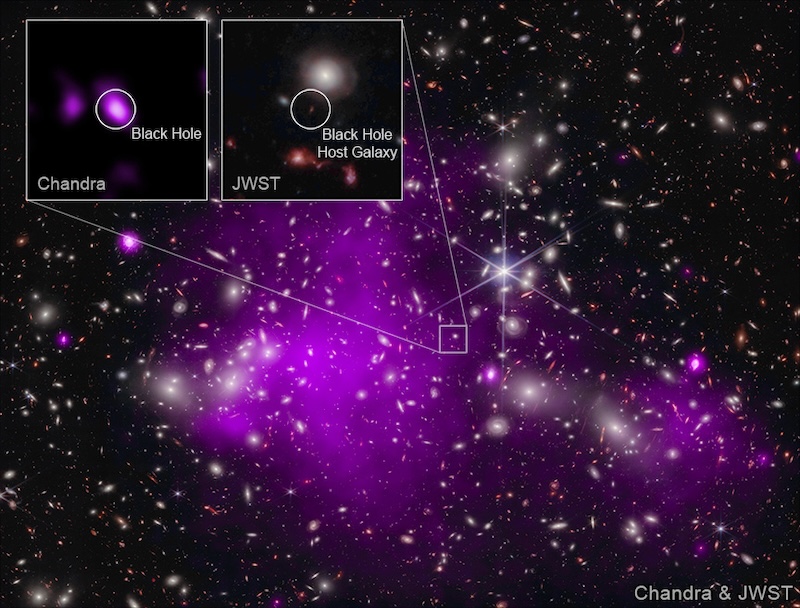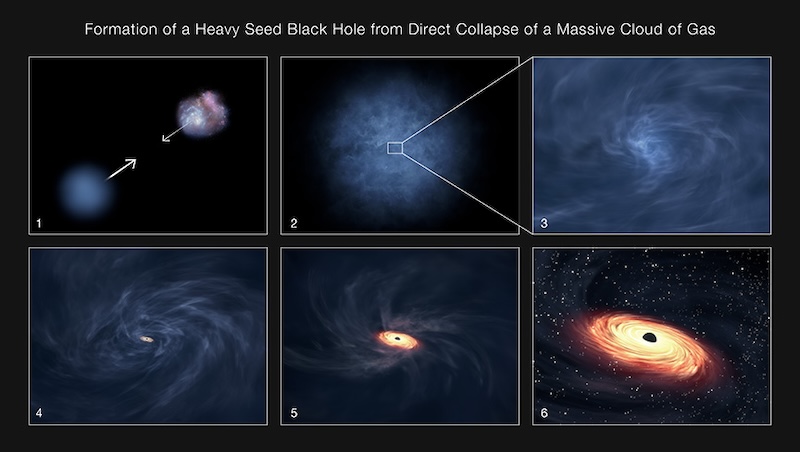
Originally published by NASA on November 6, 2023. Edits by EarthSky.
Most distant supermassive black hole discovered
Astronomers have discovered the most distant black hole yet seen in X-rays, using NASA telescopes. The black hole is at an early stage of growth that had never been witnessed before, where its mass is similar to that of its host galaxy.
This result may explain how some of the first supermassive black holes in the universe formed.
By combining data from NASA’s Chandra X-ray Observatory and NASA’s James Webb Space Telescope, a team of researchers was able to find the telltale signature of a growing black hole just 470 million years after the Big Bang.
Akos Bogdan of the Center for Astrophysics at Harvard & Smithsonian (CfA), lead author of a new paper in the journal Nature Astronomy (a preprint is available online), said:
We needed Webb to find this remarkably distant galaxy and Chandra to find its supermassive black hole. We also took advantage of a cosmic magnifying glass that boosted the amount of light we detected. This magnifying effect is known as gravitational lensing.
The 2024 lunar calendars are here! Best Christmas gifts in the universe! Check ’em out here.
The black hole is in a distant galaxy cluster
Bogdan and his team found the black hole in a galaxy named UHZ1 in the direction of the galaxy cluster Abell 2744. It’s located 3.5 billion light-years from Earth. Webb data, however, has revealed the galaxy is much more distant than the cluster, at 13.2 billion light-years from Earth, when the universe was only 3% of its current age.
More than two weeks of observations with Chandra showed the presence of intense, superheated, X-ray emitting gas in this galaxy. That is a trademark for a growing supermassive black hole. The light from the galaxy and the X-rays from gas around its supermassive black hole are magnified by about a factor of four by intervening matter in Abell 2744 (due to gravitational lensing), enhancing the infrared signal detected by Webb and enabling Chandra to detect the faint X-ray source.
This discovery is important for understanding how some supermassive black holes can reach colossal masses soon after the Big Bang. Do they form directly from the collapse of massive clouds of gas, creating black holes weighing between about 10,000 and 100,000 suns? Or do they come from explosions of the first stars that create black holes weighing only between about 10 and 100 suns?
Andy Goulding of Princeton University, a co-author of the Nature Astronomy paper and lead author of a new paper in The Astrophysical Journal Letters, said:
There are physical limits on how quickly black holes can grow once they’ve formed, but ones that are born more massive have a head start. It’s like planting a sapling, which takes less time to grow into a full-size tree than if you started with only a seed.
It appears it was born as a supermassive black hole
Bogdan’s team has found strong evidence that the newly discovered black hole was born massive. Its mass is estimated to fall between 10 million and 100 million suns, based on the brightness and energy of the X-rays. This mass range is similar to that of all the stars in the galaxy where it lives. That is in stark contrast to black holes in the centers of galaxies in the nearby universe that usually contain only about 1/10 percent of the mass of their host galaxy’s stars.
The large mass of the black hole at a young age, plus the amount of X-rays it produces and the brightness of the galaxy detected by Webb, all agree with theoretical predictions made in 2017. Co-author Priyamvada Natarajan of Yale University predicted an “Outsize Black Hole” that directly formed from the collapse of a huge cloud of gas. Natarajan said:
We think that this is the first detection of an Outsize Black Hole and the best evidence yet obtained that some black holes form from massive clouds of gas. For the first time we are seeing a brief stage where a supermassive black hole weighs about as much as the stars in its galaxy, before it falls behind.
How the black hole formed

#1 shows a massive gas cloud and a galaxy moving towards each other. If the formation of stars in the gas cloud is stalled by radiation from the incoming galaxy – preventing it from forming a new galaxy – the gas can instead be driven to collapse and form a disk and black hole.
#2 and #3 show the beginning of this gas collapse in the center of the cloud.
#4 shows a small black hole forming in the center of the disk and the black hole and disk then continuing to grow.
#5 shows the massive black hole “seed” and its disk merging with the galaxy shown in illustration #1.
#6 for a period the black hole is unusually massive compared to the mass of the stars in the galaxy, making it an Outsize Black Hole. Stars and gas from the galaxy are pulled in by the black hole, causing the black hole and disk to grow even larger.
It’s another piece in the puzzle of the early universe
The researchers plan to use this and other results pouring in from Webb, along with data from other telescopes, to fill out a larger picture of the early universe.
NASA’s Hubble Space Telescope previously showed that light from distant galaxies is highly magnified by matter in the intervening galaxy cluster, providing part of the motivation for the Webb and Chandra observations described here.
Bottom line: NASA announced the discovery of the most distant black hole yet. The supermassive black hole is at an early stage of growth and its mass is about the same as its host galaxy.
Source: Evidence for heavy seed origin of early supermassive black holes from a z~10 X-ray quasar











